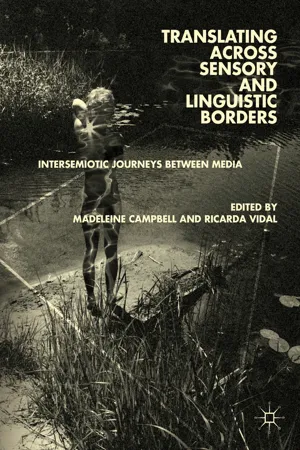In “The Task of the Translator” ([1923] 2002) Walter Benjamin reflects on the impossibility of achieving complete similarity between original and translation. Rather than locating the reason for this in the differences between languages, he argues that there is already a break between thought and language, i.e. language—whether word-based or otherwise—can never capture the essence of thought in its entirety. Translator Erín Moure (2016: 29) makes a similar point when she writes that we “always already speak a second language: we call it our mother tongue. Our first language … is the silence before speaking.” Hence, there already is a looseness in any source text long before translation is attempted—a looseness, which we can take to be a space of creative exploration.
In this chapter we will examine current terminologies and metaphors associated with translation and challenge assumptions about the boundaries between source and target, while emphasizing the role and experience of the translator in the transaction between them. We adopt a perspective of intersemiotic translation as a transactional process, different from adaptation , illustration or interpretation in the deep engagement and immersive reading of source artefacts by the translating artist, while also taking into account different approaches to loyalty or duty to an artefact’s prior instantiation. Hence, we will argue that what makes intersemiotic translation translation is not so much the end result but the process. This entails an explicit emphasis on the translator’s gaze , whereby the translator makes her/himself visible to the reader in the target artefact. As praxis this can be the way a new work is created within the limitations presented by the source text, which at the same time exposes the multiple truths afforded by this text.
With regards to literary translation Antoine Berman speaks of the “double-duty ” of the translator, which is both ethical and poetic (Berman 1995: 92, quoted by France 2013: 120). Poetic duty requires the translator to satisfy the lyrical demands of the target language by producing a work of art in its own right. While this has the potential to change the original, ethical duty demands respect for the original. Whereas the ethical is closely linked to the “truth,” the poetic is linked to “beauty.” However, in a good translation “truth” must eventually take precedence over “beauty” and the translation can then be seen as “an offering” to the original (ibid.: 121). While the interlingual translator can be fairly certain of the parameters of the source and target languages, the intersemiotic translator has the freedom of choosing and defining the target ‘language’, i.e. by choosing the material , the genre and technique that is best suited to the task.1 This freedom of choice exacerbates the difficulty in defining what constitutes the “truth,” the “essence” (Benjamin [1923] 2002) or “the most proper meaning” (Derrida 2001: 179) of a source. In fact, it is questionable whether it is at all possible or desirable to determine where the line lies between “truth” and “beauty.” Rather this ‘line’ appears to be permeable, fuzzy and blurred. Here Benjamin’s notion of “kinship” between source and translation, “which does not necessarily entail similarity” (Benjamin [1916] 1992: 52, our translation), proves to be a more fruitful concept. We can then say that translation, whether intersemiotic or interlingual, is characterised by its kinship with the source, which is expressed through loyalty and respect. It is here that it diverges from response, illustration or adaptation . As will become apparent in the chapters which comprise this volume, the translator’s gaze is guided by the search for the parameters of kinship, rather than for “essence” or “truth.”
When we write about the gaze we refer to the intense looking of the translator, which includes the full immersion of the translator in the text, with eyes, ears, skin, nose, limbs and heart. After all, even in literary translation , the translator must always employ more than just the visual sense: a poem can be read, spoken, heard, performed as well as acted out, smelled (by association) or felt. And, of course, the same goes for a painting, a film or dance, etc. We shall elaborate on this below.
Starting with an interrogation of assumptions associated with the study of translation, we propose a broad framework wherein disciplines such as semiotics , cognitive poetics , psychoanalysis and transformative learning theory may bring new perspectives to bear on the study of translation. We will illustrate our argument with examples from our own practice of intersemiotic translation: Translation Games , Wozu Image? and Jetties .
Embodied Cognition and Conceptual Metaphor Theory
We situate our perspective on intersemiotic translation within an ontology based on Maurice Merleau-Ponty’s (1945) Phénoménologie de la perception, and an epistemology underpinned by the notion that human beings apprehend the world through embodied cognition , as ascertained by George Lakoff and Mark Johnson’s 1980 Metaphors we Live by and subsequent work on cognition in conceptual metaphor theory by Lakoff and Mark Turner (1989), Raymond W. Gibbs (1994, 1999, 2006a, b, 2011), Charles Forceville and Eduardo Urios-Aparisi (2009), amongst others.
Conceptual Metaphor Theory (CMT) can be understood as an inquiry into how human beings map structures or image schemas of what they know onto more abstract elements of thought in order to understand or express these. This is initially suggested by an analysis of linguistic expressions in everyday language and literature. Perhaps the most familiar everyday spatial metaphor, formulated as “TIME IS SPACE” in CMT , relates to our propensity to speak of time in spatial terms: we conceive and speak of the future as lying ‘ahead of us’ and the past as ‘behind us’, for example (Lakoff and Johnson 1980).
In his critical review of CMT , Gibbs examined evidence and counter-evidence for its central thesis that “metaphor is as much a part of ordinary thought as it is of language” (2011: 530). Noting that hundreds of conceptual metaphors have been found in both cognitive linguistic and empiri...
